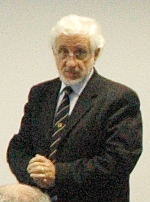Prof Andrea G Fabbri from Università di Milano-Bicocca, Italy and Prof Chang-Jo Chung from University of Ottawa, Canada presented a short course entitled ‘Hazard and Risk Assessment with Spatial Prediction Modelling Methods and Tools’.
Over a period of three days, lectures were presented on the following topics:
- Overview, aims and scope of the course
- Deficiencies in current hazard mapping and risk assessment
- Mathematical frameworks for spatial prediction models
- Practical applications and case studies: Generate hazard maps
- Uncertainty in spatial prediction models
- Cross-validation (blind test)
- From hazard map to probability map – requirements and assumptions
- Practical applications and case studies: Generate probability maps
- Overview of risk assessment
- Socio-economic data layers for risk assessment
- Practical applications and case studies: Generate risk assessment maps

Although any hazard map should show the locations of the future hazardous events with uncertainty coming from predictions of future events, from a review of current hazard mapping techniques available, there is almost no discussion on the uncertainty of the prediction. As in any prediction, the methods of how to predict do not have any scientific significance without accompanying measures of the uncertainty/validity of the prediction results. Strictly speaking, the validation of the prediction of future events is not even possible, but this course discussed several practical methodologies not only to generate the hazard maps but also to evaluate/quantize the uncertainties of the prediction. The estimation of the uncertainty was the foundation of the estimation of the probability map showing the probability of future hazardous events at each pixel under certain conditions/assumptions. By integrating the probability map with socio-economic vulnerability data, including the spatial distributions of population densities, infrastructures, the flow of goods and services, and other related economic parameters, a risk assessment map was generated.

The course was aimed at geomorphologists, environmental scientists, remote sensing specialists, geographers, spatial data analysts, GIS specialists, managers and others who wanted to understand the basic principles underlying spatial prediction models and their associated uncertainties. It covered conceptual ideas, rather than rigorous mathematics, and practical hand-on experiments. Those attending gained an understanding of the state-of-the-art and are now in a position to make informed decisions about the extent this technology is relevant to the specific problems in their respective fields of interest.
Several case studies including both earthquake- and rain-induced landslides, from Columbia, Korea, Portugal, Spain, Canada and U.S. were discussed to illustrate the procedures proposed. The estimation of the probability of occurrence of future hazardous events, based on estimated uncertainty from the cross-validation/blind-tests, provided the necessary elements of robustness and transparency to contribute to not only a decisional process but also to obtain the necessary information to generate a risk map. Risk maps were generated using assumptions and scenarios. The Spatial Target Mapping Systems and Spatial Risk Assessment System (STM-SRA), designed for the application of those techniques, was used in the practical exercises during the course. They were described and applied to the databases of the case studies. Course notes were provided to each attendee.

 Wessex Institute
Wessex Institute